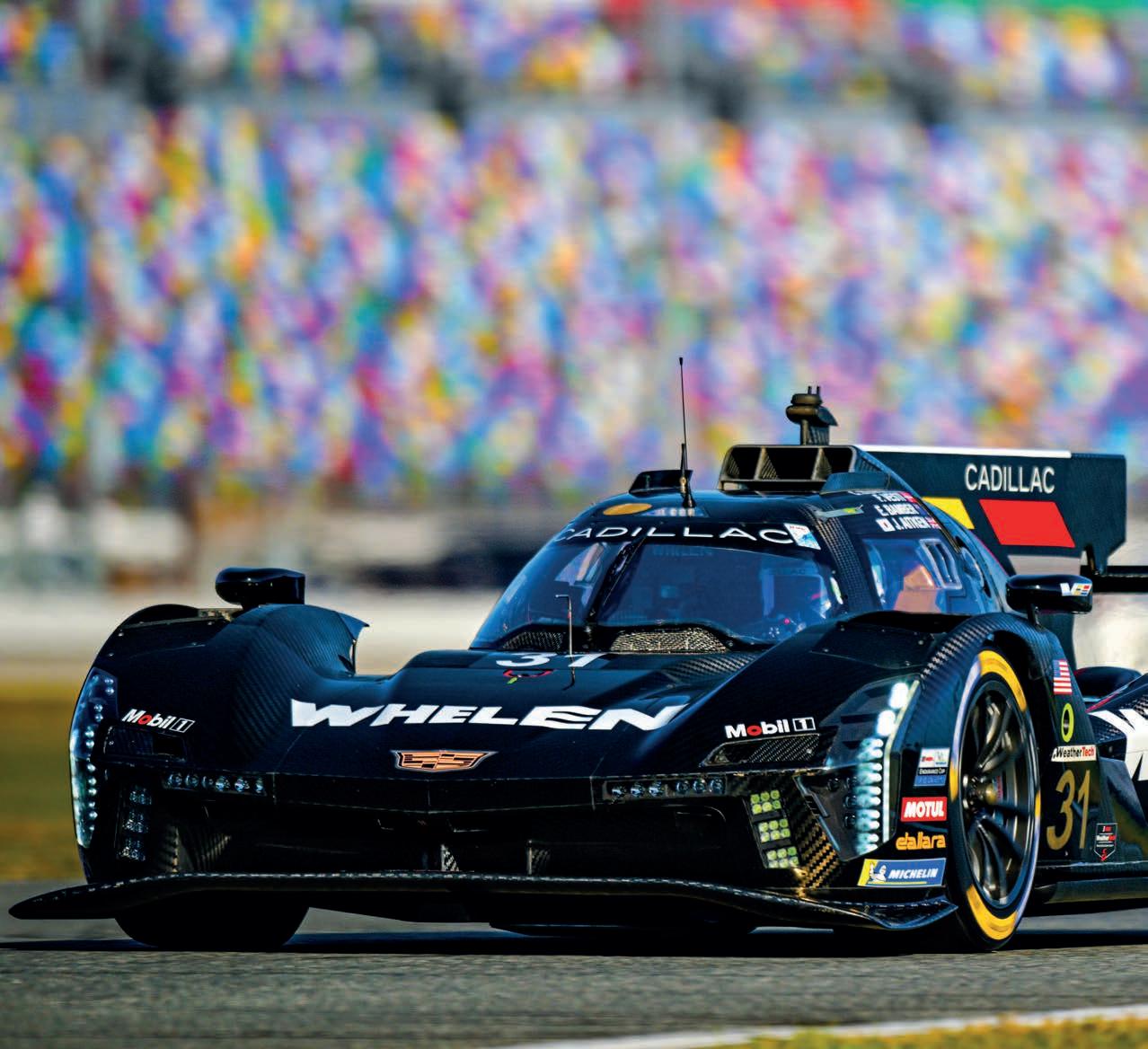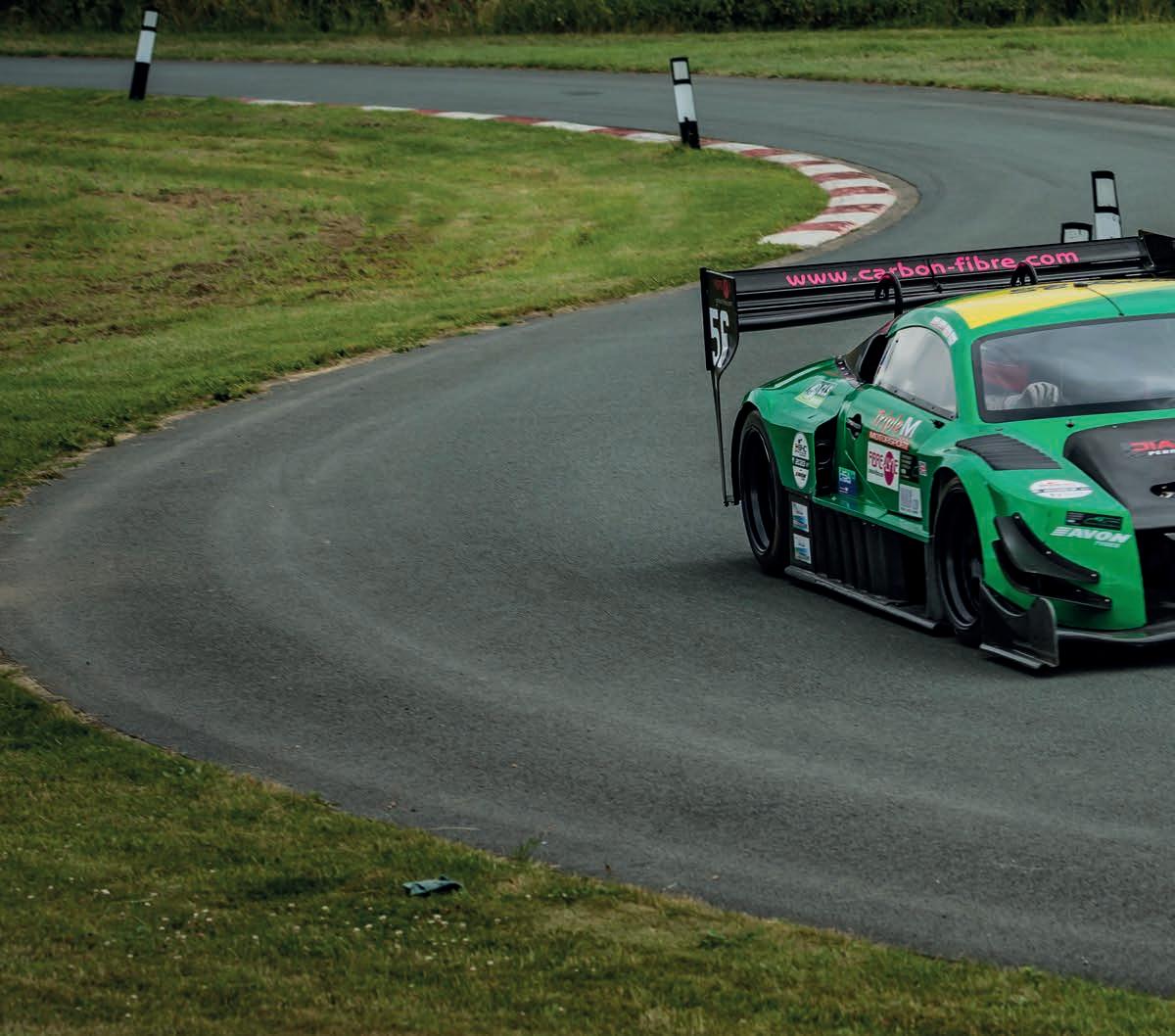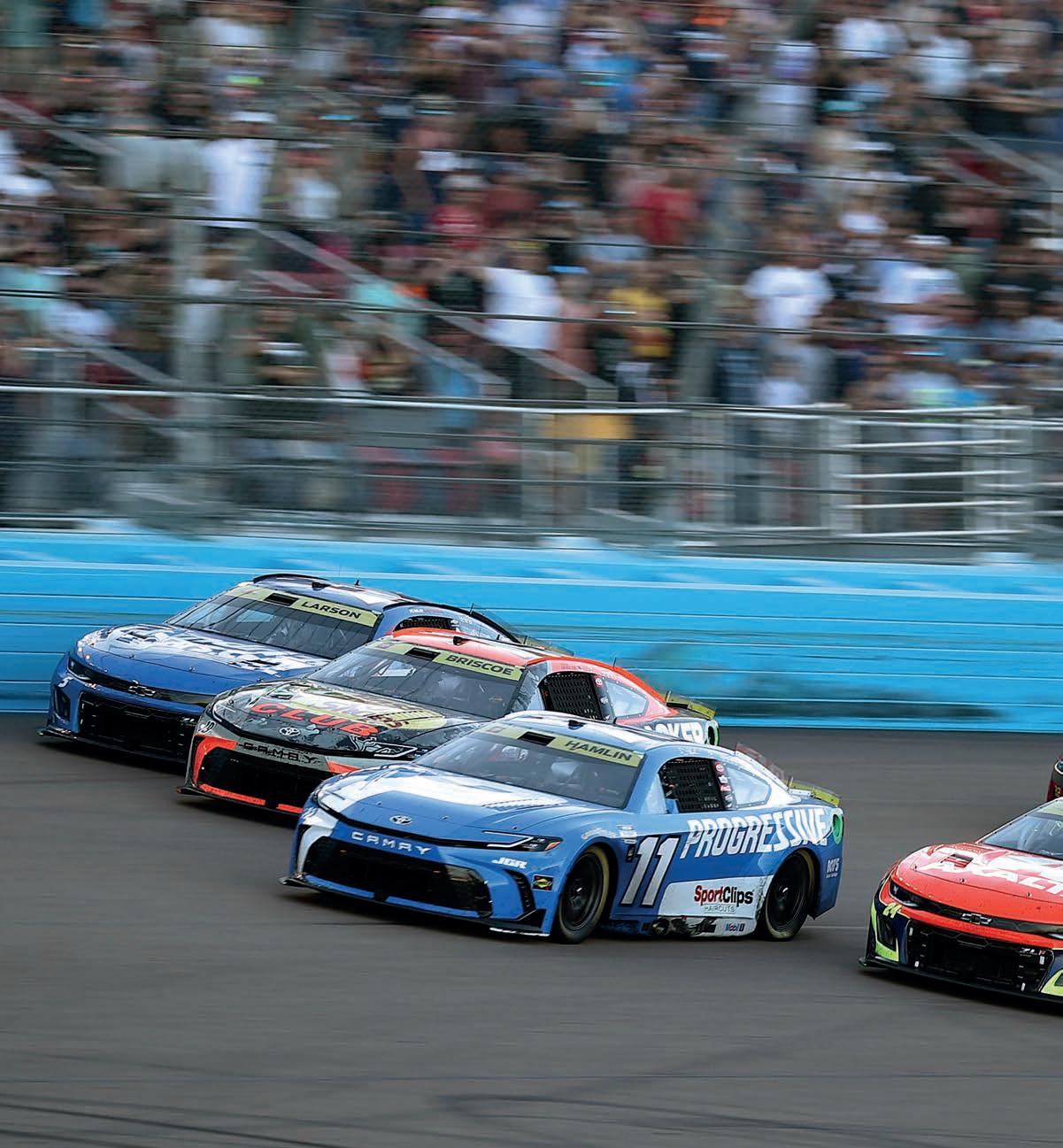








How JLR turned the Defender Octa into a competition vehicle for the Dakar’s new Stock division
By DANIEL LLOYD

The Octa already has a wider track than other Defender 110 models, and the FIA rules allow that to be increased by a further 60mm, o ering a highly robust platform




















































The Stock rules require key elements of the car, such as the engine and body, to remain the same, but Dakarspeci c modi cations are allowed, within reason



Have you ever wondered what a commonly-used 4x4 car that you see on the school run might actually be capable of? Here’s your chance. Jaguar Land Rover (JLR) is preparing to tackle the gruelling Dakar Rally in January 2026 with the D7X-R, a rallying version of the Defender Octa. It will line up in the new Stock class, which imposes strict limitations on what parts can be modi ed from the production base car. JLR, competing under the Defender brand name, has committed to three seasons in the FIA World Rally-Raid Championship (W2RC), of which the Saudi Arabia-based Dakar is the opening round.

For obvious reasons, Land and Range Rovers have historically leant themselves to long-distance rallying. The rst winner of the Dakar in 1979 was a modi ed Ranger Rover, while in recent years various independent teams have brought that famous car design to the deserts of South America and Saudi Arabia, including the Race2Recovery initiative for injured soldiers. However, this will be the rst time JLR itself has tackled the Dakar with a factory e ort.
The operation is supported by Prodrive, which has assisted with the conversion from roadgoing Octa to race-ready D7X-R, and the UK out t will be on hand to help run the three-car stable on the event.
Stock is the Dakar’s second tier class for cars. The top tier, Ultimate, is for bespoke rally-raid machinery; recent examples including the Audi RS Q e-tron, Ford Raptor and Dacia Sandrider. All are essentially prototypes built for the job. Cars in the Stock class, however, are regular passenger vehicles at their core.

The trio of D7X-Rs heading to Saudi Arabia in January were plucked from JLR’s production line at Nitra in Slovakia, starting life like every other Defender. Stock is based on the now-defunct T2 class, which was also production-based but struggled for entries in recent years. However, the FIA and Dakar promoter, the ASO, saw potential to refresh it for a new cohort of manufacturers. To ensure they got it right, technical working group discussions were held, involving the likes of Defender, Ford, Nissan and Toyota.
‘It feels like we could be the start of something really exciting for W2RC, where we almost get back to what the Dakar Rally was in the ’80s and ’90s’
Jack Lambert, head of technical integration at Defender Rally

The basic intent of Stock is to allow manufacturers to prove their production cars in competition, with scope to permit di erent drivetrains, chassis and body styles. Defender announced its three-year commitment to the class on 3 January 2025, the day the 47th Dakar Rally teed o . As an early adopter, it spent the ensuing months developing not just a new rally-raid car, but also new regulations, in dialogue with the FIA.
‘The way the car would have to be laid out was moving, at the same time as us trying to take Octa as a base vehicle, and Defender

With its bespoke carbon tub and 750bhp, twin-turbo V8, the SBR Chrono stands alone in UK hillclimb’s Sports Libre class
By MIKE BRESLIN (Photos: Rich Suckling and Bresmedia)

Stand alongside Simon Bainbridge’s hillclimb racer for any length of time and you will witness a steady stream of curious spectators approach, many of whom will then ask the same question: ‘What on earth is that?’ It’s a fair point, as there is nothing else that looks quite like this car on track, road or hillclimb course throughout the UK. There’s almost nothing else that will perform like it, either.
The car competes in the almost-anythinggoes Sports Libre hillclimb and sprint classes and, while it’s very loosely based on an Audi R8, it is a one-off build from the ground up. The car is called an SBR Chrono – the SBR short for Simon Bainbridge Racing, Chrono a reference to time – as this car races against the clock, and very effectively, too. Indeed, it scooped the highly competitive British Hillclimb Championship Tin Tops Challenge in
‘I thought I might go circuit racing with it, so it’s built as a silhouette of an [Audi] R8 from the wheel centrelines up’
Simon Bainbridge, owner / driver of the SBR Chrono

both 2024 and 2025, won the BHC Sports Libre class in 2025, and has dominated the same class in the British Sprint Championship over recent years. For those unfamiliar with the latter discipline, these are generally single lap, timed runs on circuits.
The slight similarities with an R8 in the car’s profile perhaps point to an original notion Bainbridge, a North Yorkshire farmer, had for racing the car: ‘I thought I might go circuit racing with it, so it’s built as a silhouette of an R8 from the wheel centrelines up.
‘As it was also designed for sprints, it is quite a big car [measuring in at 4250mm long by 1930mm wide] for UK hillclimbing.’
Get past the visuals, though, and you’ll find there is actually no R8 in the car whatsoever, which starts at a bespoke chassis. All the more remarkable is the fact the tub is carbon, built by John Hansell, the man behind
much of the tech work on the Chrono, and someone who has worked on other projects for Bainbridge, including the forerunner to this car, which was a 4x4 Audi TT clone that was also hugely successful in sprints.
Hansell’s business, Fibre-Lyte, is devoted to carbon fibre, which partly explains the amount of this material used on the car. There’s surely as much as you will see on any club or national level racer, including where you might expect it – the bodywork and aerodynamic elements – and other places where you might not.
‘You will be quite surprised where you see carbon,’ confirms Bainbridge. ‘The plenum chambers and the water header tank, the pedals, the propshaft; even the rockers on the suspension are made of carbon.’
By far the biggest carbon element is that tub. It’s a beautiful piece of craftsmanship and essentially one piece, although it was constructed in segments. ‘The rear bulkhead was made first, and then was incorporated into the bottom half of the tub, so the floor and the side sills and the front, which is the main structure of the car,’ Hansell explains. ‘And then the top half, the roof section, was bonded on, which enclosed the whole thing and created a box. A very, very strong box.’
The tub gives the car its rigidity, but there is also a rear roll structure with back stays to satisfy safety regulations. Other steel sections include front and rear subframes to support the suspension, engine and gearbox. While the roll bar and its supports are made from lightweight T45, the subframes are of CDS, simply because the more exotic steel is difficult to source in box section tube.

As regulations continue to tighten, the way humans think, and communicate those thoughts, offers perhaps the greatest competitive advantage of all
How race engineers use philosophy every day, whether they are aware of it or not
By JAHEE CAMPBELL-BRENNAN

What philosophy does is ask the questions equations alone cannot answer; questions about function, judgement and interpretation
Philosophy: the examination of the principles, assumptions and values that shape how we understand the world and make decisions within it.
Philosophy isn’t a word usually associated with engineering. Engineering is precise, objective and tangible. Philosophy is almost the opposite; undefined, subjective and esoteric. Yet philosophy certainly has a role within engineering, even at the highest levels.
What philosophy does is ask the questions equations alone cannot answer; questions about function, judgement and interpretation. In any process, from designing a racecar through to running a race weekend trackside, every engineer involved makes decisions that go beyond mere calculation. They must decide what to prioritise, what to ignore, even what success means.
Call it gut feeling, experience or a sixth sense, whether we have been aware of it or not, we all use a level of philosophy in our creative engineering process.
Engineering as a discipline is therefore philosophical as well as scientific. Long before we run simulations or gather data, we hold assumptions about what matters most. It might be weight, power output, aerodynamics. These beliefs steer the questions we ask and the models we create, both subconsciously and consciously. Philosophy is the examination of those assumptions, and understanding how they shape our work.
The real progress is made when the belief system can be supported by scientifically gathered data, and nowhere is that interplay more visible than in motorsport – a field that quantifies everything, delivers instant feedback, yet still relies heavily on human feel.
More than anywhere else, race engineering makes this explicit. Trackside work means juggling many things at once: car set-up; run plans; tyre preparation; tyre mileage; fuel load; data analysis; flows of information throughout the team… And, critically, managing the driver.
There is no question that the weekend’s decisions demand an objective mind steeped in scientific method and process. But in these real, raw situations, certainty is impossible. The engineer’s craft, then, is to anchor intuition to first principles, to root judgement and to mitigate guesswork.
Motor racing is effectively a big, exciting science experiment. We form a hypothesis, make predictions, design an experiment to test it, gather data, draw conclusions, and then act in the hope of improving our chances of a strong result.
As with any science experiment, it’s all about controlling your variables. Some of the variables we measure are clear and distinct, some are not. The competitors who design
By BOZI TATAREVIC
NASCAR placed teams into a much smaller operating window with the introduction of the Gen 7 car, which made its debut in 2022. Those teams have responded by finding ways to accurately adjust the smallest variables on their cars. One way they’ve been able to achieve that is by employing faster and more accurate measurement tools, and one company at the epicentre of those tools is Techmor, located in the heart of NASCAR country in Cornelius, North Carolina.
Techmor was founded by engineer, Todd Mory, in 2004 while he was in his final years as a senior engineer at Toyota Racing Development (TRD). Mory previously worked in design, development and engineering at Lutron Electronics and Visteon Corporation before moving to Ford, where he worked on a variety of projects, ranging from F1 and IndyCar to road car tyre analysis.

With racing tight and fierce, any minute advantage that can be achieved, either in car set-up or in understanding the interaction of a team’s car with those around it, is worth having. In this game, data is everything
NASCAR placed teams into a much smaller operating window with the introduction of the Gen 7 car… Teams have responded by finding ways to accurately adjust the smallest variables


By DANNY NOWLAN

Acolleague of mine once said one of the best and worst things I ever did with ChassisSim was putting a lap time on the results. He was absolutely right. On one level, particularly with the lap time simulation, you can make a change and then see if you went faster or slower. Great. However, what got lost in this was the real purpose of simulation, which is to see the fundamentals of what is going on. Sometimes, when you make a change, the fundamentals will improve but you may not necessarily see a reduction in lap time. That’s okay. To quote an old motorsport mentor of mine, sometimes you have to go backwards in order to go forwards.
Before we get stuck in, I want to address a disturbing trend I’m seeing in the motorsport vehicle dynamics simulation community, and that’s the over reliance on using thousands of simulations before an event. This is a practice you regularly see in the structures and aero simulation
communities with FEA (finite element analysis) and CFD (computational fluid dynamics). In these domains this approach works relatively well, provided your boundary conditions are well defined. Vehicle dynamics, however, is a whole different ball game. That said, there are some areas where a scatter gun sim effect can work well. Energy management in hybrid and EV applications and shaker rig simulation are good cases in point. Track replay is kind of the halfway house.
However, in lap time simulation, this approach can really bite you hard if you’re not careful. In predicting how fast you are going to go in any given situation, many different elements come into play. It’s not just raw speed. It can be set-up driven: have we gone too soft? By moving the aero balance forward, have we made the car unstable? In the latter case, there are certain elements that can be done to mitigate this, but invariably one of the simulation corollaries of Murphy’s Law says if there are any weaknesses in the model, running thousands of simulations can show this up.
One of ChassisSim’s contemporaries, LapSim by Bosch Motorsport, doesn’t have a multi-sim function for this very reason. In ChassisSim, the way we designed set-up sweeping forces you to interrogate the results. Nothing replaces the human brain in the loop, and we are about to see why in this article.
The first case study I want to talk about is when I was using lap time simulation to obtain a calibration for what I needed for a spring / bump rubber package for a high downforce Time Attack car. This predates Tanuki, a project I’ve been working on recently, by the way!
In this example, I couldn’t give a hoot about how fast the car was. What I was interested in was what rates I needed for the third spring bump rubbers, and what gaps I was going to need to hold the car up. The results are shown in figure 1
Here we have speed, combined front and rear dampers (front and rear pitch, respectively), ride heights and the front